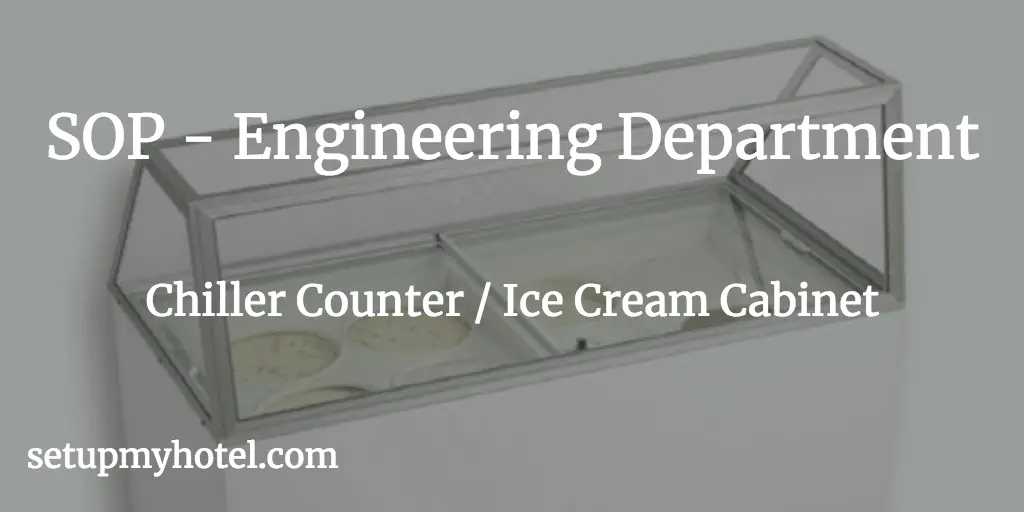Standard Operating Procedure for Chiller Counter / Ice Cream Cabinet
When it comes to engineering in hotels, one crucial aspect is ensuring the proper functioning of the chiller counter and ice cream cabinet. This not only ensures that the guests have access to refreshing and delicious treats, but it also helps maintain the quality of the food items. To ensure that everything is in order, it’s essential to follow a comprehensive checklist.
This checklist should cover all the aspects of the chiller counter and ice cream cabinet, including the cleanliness of the machine, the temperature control, the stock availability, and the overall functionality. By keeping a close eye on all these elements, hotels can ensure that their guests have a pleasant experience and enjoy the best quality food items.
Additionally, routine maintenance and inspections can help prevent any unexpected breakdowns or malfunctions, thereby minimizing any inconvenience caused to the guests. In conclusion, a well-maintained chiller counter and ice cream cabinet is an essential aspect of hotel engineering, and following a comprehensive checklist can help ensure its smooth functioning.

Chiller Counter Maintenance Checklist and Procedure:
Required Tools:
- Screwdriver.
- Clamp meter.
- Crimping Tool.
- Air Blower.
- OilSeveral kinds of oil are used to make salad dressing;e.g. olive; peanut; sunflower; walnut; grape se... Can.
- Plier.
- Spanner SetSet: Allowing an item to go from a soft or liquid state to a firmer more solid state..
- Brush.
- Gasket.
- Line Tester.
Consumable Parts:
- PVC tape.
- Lubricating Oil.
- Carbon removing compound.
- Old cleaning clothes.
Chiller Cabinet Maintenance Activity:
- Check the condenser motor bush and shaft.
- Check compressor High amps & noise level.
- Check MCB for loose and burnt electrical connections.
- Check and verify the rating of MCB in place.
- Earthing should be proper at all times.
- Extension cord burnt, cut in wire to be checked and repaired if needed.
- Proper tumbling is to be checked, and any burnt connections and thimbles are to be checked.
- Check and verify the operation of the relays used.
- Check for any electrical loose connection.
- Doors/Handles – Check if the handle is loose and also the operation.
- Latch – operation to check.
- Door gaskets – broken gasket and cooling leakage to be checked.
- Cleaning – General cleaning to be done.
- Condenser Fan – Loose & broken fan blade.
- Check Temperature is between 4-6 Deg. C.
- Check if the compressor on full Load should be 5 Amp.
- Check and verify that the MCB rating should be 20 Amp.
Remarks by the Technician:
Date:
Signature:
Training Questions:
- Why is it crucial to calibrate instruments regularly?
- What does the SOP recommend in terms of the frequency of instrument calibration?
- Who is responsible for performing the calibration according to the SOP?
- Explain the significance of maintaining a master list for instruments and how it aids in the calibration process.
- In case an instrument is found out of calibration, what steps does the SOP suggest taking, and who is involved in the process?
- Describe the information included in the Calibration Card/Sticker.
- What should be checked upon receiving the calibration certificate for an instrument?
- Why is it important to provide training to users on the safe handling and storage of instruments?
- How does the SOP suggest handling instruments found out of calibration, and what actions may be taken, including changes in calibration frequency?
- Explain the purpose of the calibration sticker or card on the instrument.
- What are the potential consequences of using instruments that are not regularly calibrated?
- Provide an example of a situation where an instrument may need its calibration frequency adjusted based on calibration results.
- How does the SOP recommend ensuring traceability to the national standard in the calibration process?
Patreon Only SOP Download
SOP Number: Hotel Engineering SOP – 14 Department: Engineering and Maintenance Date Issued: 26–Feb-2018 Time to Train: 30 Minutes












